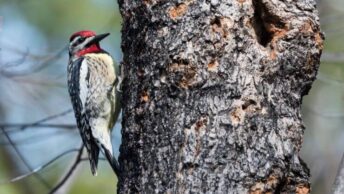Blue birds bring a special kind of brightness to Illinois landscapes, whether you’re hiking through quiet woodlands or just looking out your kitchen window. From the bold calls of the Blue Jay echoing through oak trees to the softer songs of an Indigo Bunting perched on a roadside fence, these birds stand out with their striking colors and lively personalities. Even in ordinary places, like city parks, farm fields, or neighborhood gardens, you can spot flashes of blue that make you pause for a better look.
Some of these species, like the Eastern Bluebird, have become conservation success stories after years of decline. Others, including Tree Swallows and Barn Swallows, return every spring to raise their young in nest boxes and old barns. You might even catch sight of a Belted Kingfisher hovering over a river before plunging headfirst into the water.
This article will introduce you to several of the most notable blue birds found in Illinois, offering tips on where to find them, how to recognize them, and what makes each one unique. With a little patience and curiosity, you’ll discover how much these birds can brighten even the most ordinary day outside.
1. Eastern Bluebird
- Scientific name: Sialia sialis
- Life span: 6–10 years
- Size: 6.3–8.3 in (16–21 cm)
- Weight: 1.0–1.1 oz (28–32 g)
- Wingspan: 9.8–12.6 in (25–32 cm)
- Status: Least Concern
- State status: Breeding and common
- Migratory behaviour: Many stay year-round; some migrate south in winter.
The Eastern Bluebird is found across eastern North America, from southern Canada down through Florida and into parts of Mexico. Males are known for their bright blue backs and rich reddish-orange chests, which stand out against open fields and meadows. Females are softer in color, with pale blue wings and a warm tan breast. Their gentle presence and sweet warbling songs make them a favorite among birdwatchers and gardeners alike.

Eastern Bluebirds nest in tree cavities or specially designed nest boxes in open fields and edges of woodlands. Females build neat cup-shaped nests lined with grass and pine needles. They often raise two or three broods each season, returning to the same territory year after year as long as there are safe spots for nesting and plenty of insects nearby.
They eat insects during warm months, searching for beetles, grasshoppers, and caterpillars by dropping to the ground from low perches. In fall and winter, they switch to berries and fruits like dogwood and sumac. You might spot them along fences, patiently scanning the ground for any movement that hints at hidden prey.
Eastern Bluebird populations declined in the mid-20th century due to habitat loss and competition from starlings and House Sparrows. Conservation groups established nest box trails to help them recover. Thanks to those efforts, they’ve made a strong comeback across Illinois and much of their range.
2. Indigo Bunting
- Scientific name: Passerina cyanea
- Life span: Up to 10 years
- Size: 4.7–5.1 in / 12–13 cm
- Weight: 0.4–0.6 oz / 12–18 g
- Wingspan: 7.5–8.7 in / 19–22 cm
- Status: Least Concern
- State status: Migratory and common
- Migratory behaviour: Leaves by late September; winters in Central America.
The Indigo Bunting breeds throughout the eastern and central United States and migrates to Central America for the winter. Males are striking, covered almost entirely in vibrant blue feathers that glow in the sunlight. Females and young birds are a warm brown, blending easily into thickets and hedgerows. These small finches often perch high on exposed branches to sing their bright, clear songs all summer.

Indigo Buntings build their cup-shaped nests in shrubs or low trees along field edges and roadsides. The female does nearly all the construction, weaving grasses and leaves together and lining the nest with soft fibers. She incubates the eggs alone, while the male sings persistently to defend the territory.
They feed mainly on small seeds from grasses and weeds, especially in late summer. During breeding, they also eat insects to fuel long days of singing and nesting. Indigo Buntings often forage low among thickets, slipping in and out of leaves with quick, careful movements.
Indigo Buntings remain widespread and common. Habitat loss is always a concern, but their ability to use edges and overgrown fields has helped them persist. Monitoring programs track their numbers each year, and maintaining hedgerows is an important part of keeping their populations strong.
3. Blue Jay
- Scientific name: Cyanocitta cristata
- Life span: 7 years on average
- Size: 9–12 in (22–30 cm)
- Weight: 2.5–3.5 oz (70–100 g)
- Wingspan: 13–17 in (33–43 cm)
- Status: Least Concern
- State status: Breeding and common
- Migratory behaviour: Mostly resident; some migrate short distances in fall.
Blue Jays are widespread across the eastern and central parts of North America. They have bold blue plumage on their backs and wings, with black barring and white highlights. A prominent crest on the head can be raised or lowered depending on their mood. Their black necklace and pale face create a striking contrast. Known for loud calls and curious behaviour, they are frequent visitors to backyards.
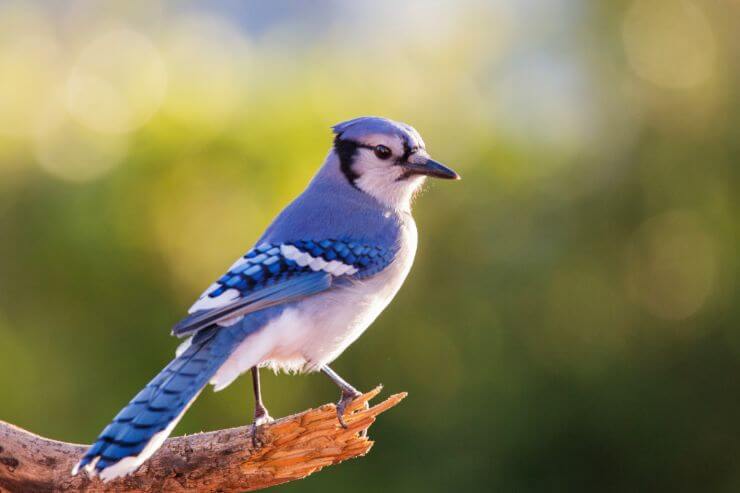
Blue Jays build sturdy nests high in trees, usually in forks of branches. Both parents gather twigs and mud, then line the cup with softer materials like rootlets. They’re fiercely protective, often screaming and diving at anything that ventures too close to their nest during breeding season.
Their diet includes acorns, nuts, insects, and occasional small animals. Blue Jays also cache food, burying acorns in hidden spots to retrieve later. You’ll often see them hopping along branches, turning leaves and probing bark with their strong bills in search of something to eat.
Blue Jays have remained secure across Illinois. They benefit from suburban yards with mature trees and feeders. Although some people find them noisy, their role in dispersing oak trees by caching acorns helps sustain forests. Conservation mainly focuses on protecting large trees and natural woodlands.
4. Tree Swallow
- Scientific name: Tachycineta bicolor
- Life span: 2-3 years
- Size: 4.7–5.9 in (12–15 cm)
- Weight: 0.6–0.9 oz (17–25 g)
- Wingspan: 11.8–13.8 in (30–35 cm)
- Status: Least Concern
- State status: Breeding and common
- Migratory behaviour: Migrates south by October to Gulf Coast and beyond.
Tree Swallows are common across North America, breeding as far north as Alaska and wintering in the southern United States and Central America. Their smooth, iridescent blue-green backs shimmer in the sun, while their underparts remain clean white. Long, pointed wings and a slightly forked tail give them a graceful look as they swoop over ponds and fields in search of insects.

Tree Swallows nest in cavities in trees or nest boxes set near open fields and wetlands. The female lines the cavity with grasses and feathers collected from the surrounding area. Both parents feed the nestlings constantly, swooping out over fields and water to catch insects.
They eat flying insects almost exclusively, including flies, beetles, and midges. In cool weather, Tree Swallows can also digest plant material like bayberries. Their graceful, gliding flight makes them easy to spot as they dart and twist to snatch prey mid-air over ponds and fields.
Tree Swallow populations remain strong and even increased thanks to nest box programs. They readily accept human-made cavities, which helps offset losses of natural nesting sites. Conservation efforts focus on maintaining wetlands and providing safe, clean areas for breeding near open water.
5. Barn Swallow
- Scientific name: Hirundo rustica
- Life span: 4–8 years
- Size: 15–20 cm / 5.9–7.9 in
- Weight: 16–22 g / 0.6–0.8 oz
- Wingspan: 32–34 cm / 12.6–13.4 in
- IUCN Status: Least Concern
- State status: Migratory and common
- Migratory behaviour: Departs by early fall; winters in South America.
The Barn Swallow ranges across most of North America during the breeding season, migrating to South America for the winter. These swallows are recognized by their glossy blue backs, cinnamon-coloured throats, and deeply forked tails. Their pointed wings and quick, fluid flight make them agile hunters. They often build mud nests on barns, bridges, and other structures near open country.
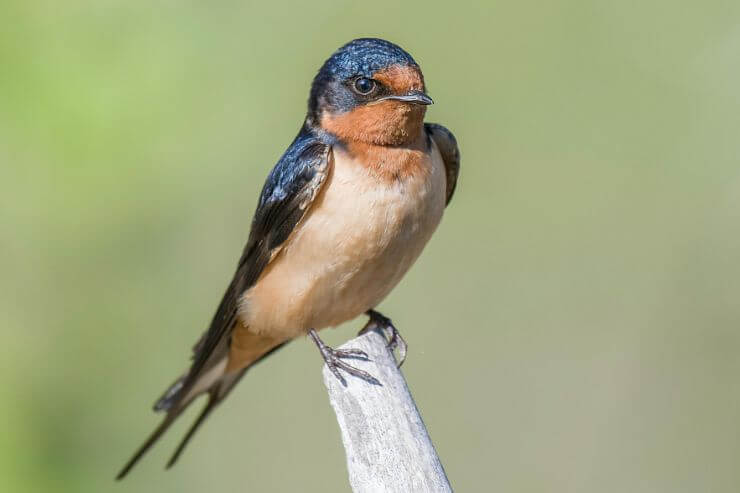
Barn Swallows build cup-shaped nests from mud mixed with grass, attaching them to beams inside barns, under bridges, or on porches. Both adults gather materials and shape the nest carefully. They often reuse or repair the same nest each year when they return from migration.
Their diet is made up almost entirely of flying insects. Barn Swallows skim low over fields and ponds, catching mosquitoes, beetles, and moths in fast, acrobatic flight. Their long, forked tails and smooth wingbeats make them instantly recognizable as they hunt over open spaces.
Barn Swallow populations are generally stable, though modern building designs have reduced nesting spots. Encouraging safe nest sites in barns and sheds helps maintain numbers. They benefit from clean air and water, so conservation also involves keeping insect populations healthy and habitats free of pesticides.
6. Purple Martin
- Scientific name: Progne subis
- Life span: Up to 13 years
- Size: 7.5–7.9 in (19–20 cm)
- Weight: 1.6–2.1 oz (45–60 g)
- Wingspan: 15.3–16.1 in (39–41 cm)
- Status: Least Concern
- State status: Breeding and common
- Migratory behaviour: Leaves by August; migrates to Brazil for winter.
Purple Martins breed throughout much of the eastern United States and migrate to Brazil in winter. Adult males are glossy blue-black all over, while females and young birds have paler bellies and darker upperparts. They nest in colonies, often in special houses set up by people. When perched together on wires or gourds, their cheerful, bubbling calls fill the air around lakes and neighbourhoods.

Purple Martins nest almost entirely in human-provided housing, such as multi-compartment boxes and gourds. Males arrive first to claim territories, then sing and display to attract females. Pairs line the nesting cavity with leaves and grass, raising one brood each summer in their communal colony.
They feed on flying insects captured in open air. Purple Martins forage high over fields and lakes, catching dragonflies, beetles, and moths. Their chattering calls carry across open spaces, especially in the evenings when large groups return to their nest sites to settle in for the night.
Conservation groups promote putting up martin houses, which are vital because of the loss of natural cavities. These efforts have helped Purple Martins remain common in Illinois. Active management and public interest continue to support their colonies and encourage new generations to return every spring.
7. Cerulean Warbler
- Scientific name: Setophaga cerulea
- Life span: Up to 6 years
- Size: 4.3 in / 11 cm
- Weight: 0.3 oz / 8.5 g
- Wingspan: 7.9 in / 20 cm
- Status: Near Threatened
- State status: Migratory and rare
- Migratory behaviour: Migrates south in August; winters in Andes forests.
The Cerulean Warbler breeds in mature deciduous forests across the eastern United States, especially in tall trees with an open canopy. Males are delicate sky blue above, with white underparts and a dark band across the throat. Females are greenish-blue and lightly streaked. These warblers are uncommon and often stay high in the treetops, making them a special find for patient observers.
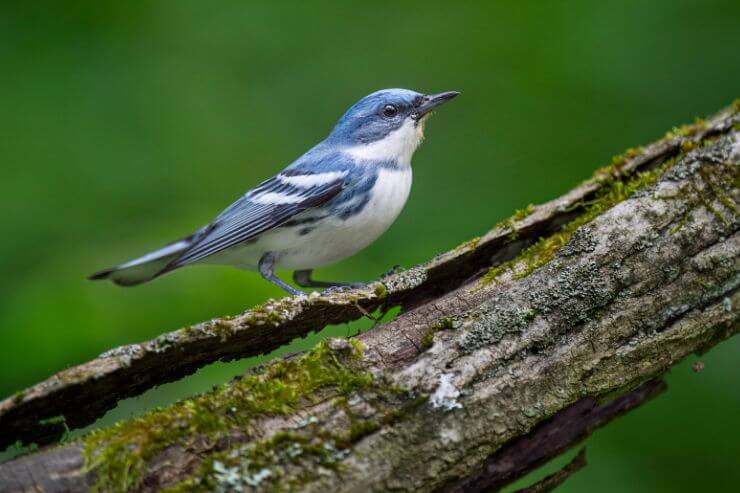
Cerulean Warblers nest high in mature deciduous trees, often near streams or steep hillsides. Females build a delicate cup nest on a horizontal branch far above the ground, making them difficult to see. Males sing persistently from the canopy to mark territory.
They feed mostly on insects gleaned from leaves and twigs. Cerulean Warblers move quickly among branches, picking caterpillars and small beetles. Their graceful, deliberate foraging and sweet, rising songs make them a special reward for birders lucky enough to glimpse them high in the trees.
Cerulean Warbler populations have declined due to habitat loss and fragmentation. Conservation focuses on preserving large tracts of mature forest and protecting important stopover sites. Monitoring and research continue to track their status and inform management strategies to keep them from becoming rarer.
8. Northern Parula
- Scientific name: Setophaga americana
- Life span: 5-6 years
- Size: 4.3 in / 11 cm
- Weight: 0.3 oz / 7.5–8 g
- Wingspan: 6.3–7.1 in / 16–18 cm
- Status: Least Concern
- State status: Breeding and uncommon
- Migratory behaviour: Migrates south by early fall to Central America.
The Northern Parula is a small and brightly coloured warbler found in the eastern United States, with a breeding range that includes southern Ohio. It prefers forested areas with hanging moss or old-man’s beard lichen, which it uses for nesting material. Males are especially striking, with bluish upperparts, a yellow throat and chest, and a greenish back patch. A bluish-gray hood and two white wing bars complete the look. Females are duller but still colourful.
These birds tend to stay in the canopy, making them harder to see despite their bright appearance. Their trilling, buzzy song rises up in pitch and often gives away their location. They are most often found in forests near water, especially during spring migration and in summer breeding territories. Though not rare, their quiet behaviour and preference for higher foliage make them less noticeable than their colors might suggest.

Northern Parulas nest in hanging moss or lichens like old-man’s beard, which they use to form hammock-like nests high in trees. In Ohio, where such moss is scarcer, they may nest in other hanging vegetation or clumps of leaves. Nesting usually occurs in moist woodlands or near streams, where insect life is abundant.
They eat a wide variety of insects and spiders, which they pick from leaves, twigs, and bark in the canopy. They are active foragers, hopping and fluttering through foliage. Occasionally, they hover briefly to snatch insects mid-air or probe into curled leaves where bugs are hiding.
Northern Parula populations have remained relatively stable, though regional declines are tied to air pollution, forest clearing, and the loss of nesting materials like lichens. In Ohio, they breed mainly in the southern part of the state. Forest preservation and clean air policies support the mosses and habitats they rely on.
9. Black-throated Blue Warbler
- Scientific name: Setophaga caerulescens
- Life span: Up to 9 years
- Size: 5.1 in / 13 cm
- Weight: 0.3–0.4 oz / 8–11 g
- Wingspan: 7.5–8.7 in / 19–22 cm
- Status: Least Concern
- State status: Migratory and rare
- Migratory behaviour: Passes through in migration; leaves by October.
Black-throated Blue Warblers breed in northeastern forests and migrate through the Midwest. Males have a rich dark blue back, black face and throat, and clean white underparts that create a sharp, elegant look. Females are olive-brown with a pale eyebrow. These warblers prefer dense understory growth, where they move deliberately through leaves while searching for insects during migration stops.
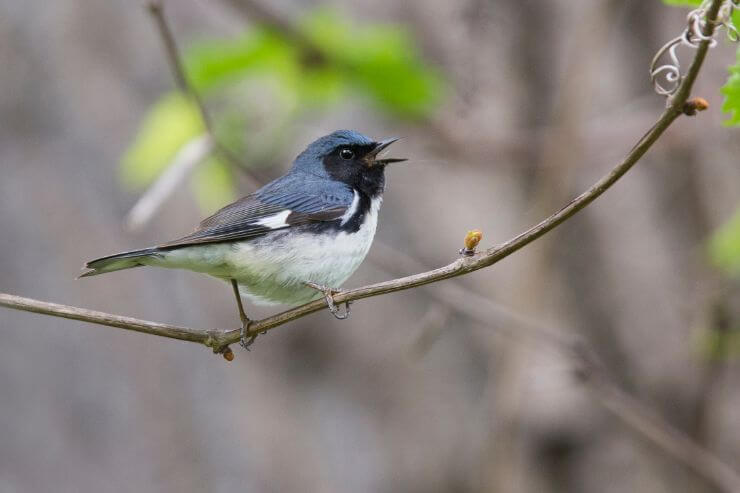
Black-throated Blue Warblers nest in dense understory shrubs of mature forests, usually in hilly or mountainous areas. The female builds a small, well-concealed nest a few feet above the ground. Males guard the territory and sing a soft, buzzy song from nearby perches.
They feed on insects and spiders collected from leaves. These warblers move slowly and deliberately, flicking their tails to reveal white spots as they search. Unlike many warblers, they often stay low in thickets, making them easier to see during migration and breeding.
Though uncommon migrants in Illinois, they remain stable overall. Conservation focuses on preserving large, unbroken forests for breeding habitat. Birders contribute valuable records by documenting sightings during migration, helping track changes in distribution and population over time.
10. Blue Grosbeak
- Scientific name: Passerina caerulea
- Life span: Up to 9 years
- Size: 5.5–7.5 in (14–19 cm)
- Weight: 0.9–1.1 oz (26–31 g)
- Wingspan: 10–11 in (25–28 cm)
- Status: Least Concern
- State status: Migratory and rare
- Migratory behaviour: Heads south by September; winters in Mexico and Central America.
The Blue Grosbeak breeds in the southern and central United States and winters in Mexico and Central America. Males are a deep, rich blue all over, accented by two chestnut wing bars. Females are warm brown, blending into shrubs and brush. These secretive songbirds often perch in dense thickets along roadsides and overgrown fields, where they sing soft, musical notes.

Blue Grosbeaks nest in dense shrubs or brushy edges near fields and roads. Females build a sturdy cup nest lined with grass and rootlets, hidden deep in foliage. Males sing from exposed perches above the nest site to defend territory.
They feed mainly on insects and seeds collected in fields and roadsides. Blue Grosbeaks forage low in vegetation or on the ground. Their thick bills crack seeds easily, and they often pause to watch carefully before dropping down to pick food.
In Illinois, Blue Grosbeaks are locally uncommon but expanding. Conservation efforts encourage maintaining shrubby habitats and planting native vegetation. Monitoring helps track their slow but steady spread northward. Protecting open areas with dense cover is important for their continued success.
11. Belted Kingfisher
- Scientific name: Megaceryle alcyon
- Life span: Up to 14 years
- Size: 11–14 in (28–35 cm)
- Weight: 4.9–6 oz (140–170 g)
- Wingspan: 19–23 in (48–58 cm)
- Status: Least Concern
- State status: Breeding and common
- Migratory behaviour: Many stay year-round if water remains unfrozen.
The Belted Kingfisher lives near rivers, lakes, and coasts across much of North America. Slate-blue above, it has a shaggy crest and a bold white collar around the neck. Females are distinguished by an extra rusty band across the chest. They often sit quietly on branches over water, watching for fish before plunging down in a swift, headlong dive to catch their prey.

Belted Kingfishers nest in burrows excavated into vertical riverbanks or sandy cliffs. Both sexes dig long tunnels, ending in a chamber where eggs are laid. The burrow stays cool and hidden from predators. They often reuse the same nesting site year after year.
They feed mostly on small fish, diving headfirst into water from a perch. Kingfishers also take crayfish and aquatic insects. Their loud rattling calls echo along rivers and lakeshores as they patrol territories, flying with quick wingbeats and short glides.
Belted Kingfishers remain widespread and common. Conservation focuses on protecting clean waterways and preserving natural banks for nesting. Because they rely on healthy fish populations, their presence often signals good water quality. Habitat preservation ensures they continue to thrive along Illinois waterways.
Where to find Blue birds in Illinois
If you’re hoping to see blue birds in Illinois, you don’t have to look far, many can be found in open fields, wooded edges, and even city parks. Early mornings are usually best, when birds are most active and light catches their colors just right. Bring binoculars and move slowly, watching for any flash of blue in the trees or along fences.
Eastern Bluebirds often perch on wires near open grassy areas. Tree Swallows and Barn Swallows swoop low over ponds, while Indigo Buntings sing from shrubs along trails. If you’re near water, keep an eye out for Belted Kingfishers flying with their rattling calls.
Four great places to see a variety of blue birds are Midewin National Tallgrass Prairie, where bluebirds and buntings nest along open paths, and Starved Rock State Park, which has wooded bluffs perfect for warblers. Montrose Point Bird Sanctuary in Chicago is excellent for spring migration when many species pass through. Cache River State Natural Area in southern Illinois combines wetland and forest habitats, drawing swallows and kingfishers.
Conclusion
Blue birds bring color, energy, and a sense of wonder to Illinois, whether you’re exploring a quiet trail or sitting in your own backyard. From the bright splash of an Indigo Bunting to the steady presence of a Blue Jay, each species adds something special to the landscape. Taking time to notice them not only enriches your day but also deepens your connection to the nature that’s always close by, waiting to be discovered.

